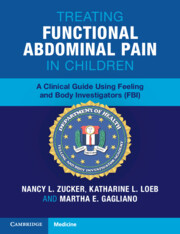 Treating Functional Abdominal Pain in Children
Treating Functional Abdominal Pain in Children Book contents
- Treating Functional Abdominal Pain in Children
- Treating Functional Abdominal Pain in Children
- Copyright page
- Dedication
- Contents
- Acknowledgements
- Part I The Background Science Behind Feeling and Body Investigators
- Chapter 1 Becoming a Feeling and Body Investigator – Pain Division
- Chapter 2 Visceral Sensitivity as a Superpower
- Chapter 3 Responsive Parenting and Creating Safety
- Chapter 4 Discriminating Safe from Threatening Body Sensations: The Science of Interoceptive Exposures
- Chapter 5 The Medical Evaluation of Abdominal Pain in Children – One General Pediatrician’s Approach
- Part II A Session-by-Session Guide to Feeling and Body Investigators
- Part III Sample Workbook Pages, Handouts, and Additional Resources for Feeling and Body Investigators
- Index
- References
Chapter 2 - Visceral Sensitivity as a Superpower
from Part I - The Background Science Behind Feeling and Body Investigators
Published online by Cambridge University Press: 18 November 2023
- Treating Functional Abdominal Pain in Children
- Treating Functional Abdominal Pain in Children
- Copyright page
- Dedication
- Contents
- Acknowledgements
- Part I The Background Science Behind Feeling and Body Investigators
- Chapter 1 Becoming a Feeling and Body Investigator – Pain Division
- Chapter 2 Visceral Sensitivity as a Superpower
- Chapter 3 Responsive Parenting and Creating Safety
- Chapter 4 Discriminating Safe from Threatening Body Sensations: The Science of Interoceptive Exposures
- Chapter 5 The Medical Evaluation of Abdominal Pain in Children – One General Pediatrician’s Approach
- Part II A Session-by-Session Guide to Feeling and Body Investigators
- Part III Sample Workbook Pages, Handouts, and Additional Resources for Feeling and Body Investigators
- Index
- References
Summary
Children with sensory superpowers live life out loud! They have a vivid experience of themselves and the world around them that adds richness to life. Pain sensitivity does not have to be a vulnerability. This chapter is about reframing visceral hypersensitivity as an asset that contributes to three specific superpowers. First, children with visceral sensitivity have spell-binding powers of perception. Because of their history of pain, children may become hyper-vigilant and scared of all the sensations they notice. As they become FBI agents, children learn to harness this perception and use playfulness and curiosity to detect body clues and investigate body mysteries. Second, children with visceral hypersensitivity have awe-inspiring self-awareness. Readers learn about the function, power, and experience of emotions. The intensity with which children feel their bodies runs parallel to strong emotions that can provide vital information to help them get to know and trust themselves. Finally, children with sensory superpowers have faster-than-lightening intuitive decision-making capacities. We explore how sensitivity to physical sensations in the gut can translate to strong feelings that help one “go with their gut” reaction. This chapter links how the tools of the FBI intervention are designed to harness and build each of these superpowers.
Keywords
- Type
- Chapter
- Information
- Treating Functional Abdominal Pain in ChildrenA Clinical Guide Using Feeling and Body Investigators (FBI), pp. 9 - 21Publisher: Cambridge University PressPrint publication year: 2023


